Economics and Healthcare: Funding, Casemix & Nurse Management
VerifiedAdded on 2023/06/15
|13
|3609
|271
Essay
AI Summary
This essay delves into the application of economic concepts, funding models, and casemix-based management information systems within the healthcare environment, particularly in the Australian context. It explains allocative efficiency, technical efficiency, opportunity cost, and cost-effectiveness analysis, providing practical examples relevant to healthcare delivery. The essay also describes activity-based funding (ABF) and its role in incentivizing accountability, driving efficiency, and improving access to care, while also identifying healthcare activities not currently funded under ABF. Furthermore, it discusses the types of information casemix-based management information systems provide for nurse managers, emphasizing the importance of resource management, quality measurement, and clinical validity in healthcare facilities. The Independent Hospital Pricing Authority (IHPA) and National Efficient Price (NEP) are mentioned in relation to ABF, and the essay highlights the significance of casemix index (CMI) in determining resource allocation and improving patient outcomes.
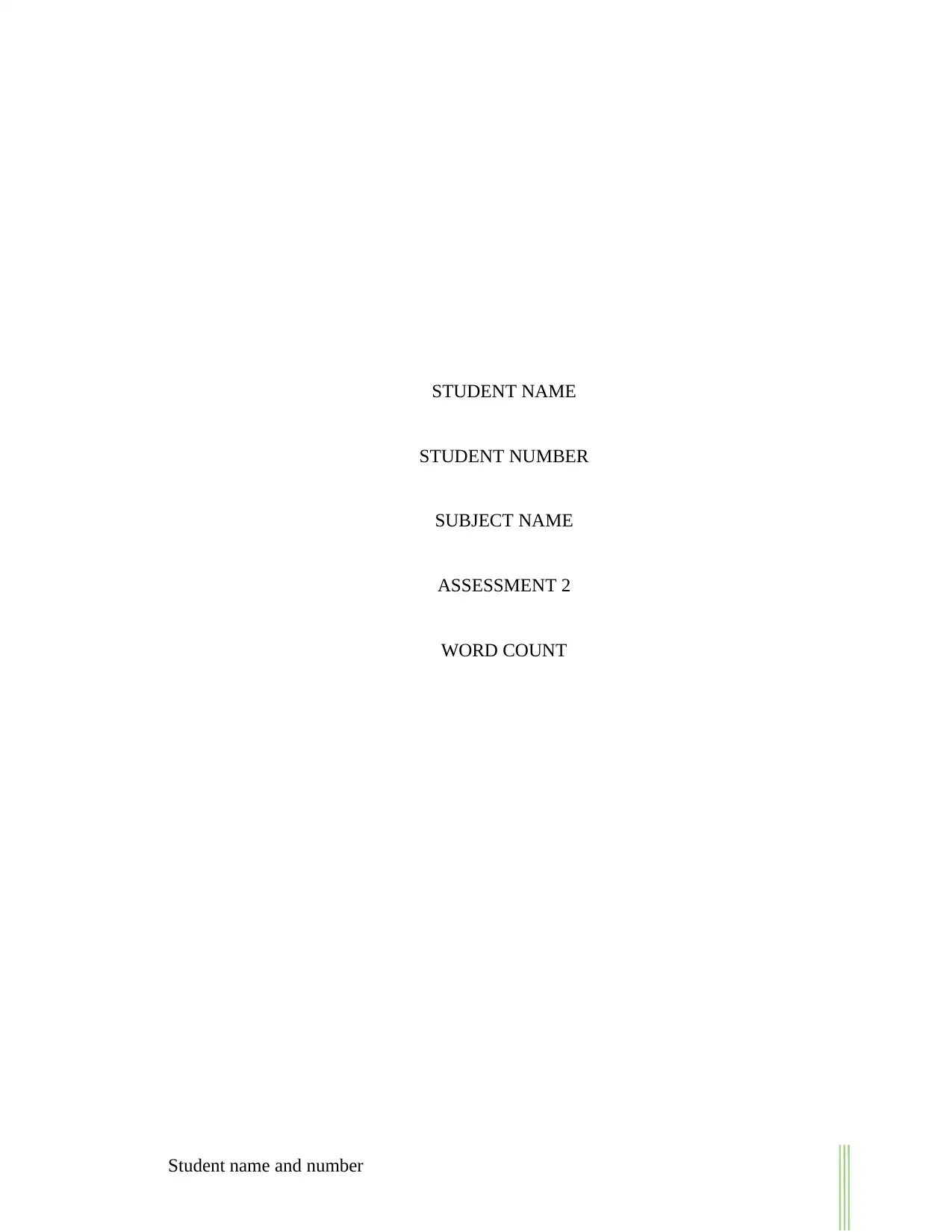
STUDENT NAME
STUDENT NUMBER
SUBJECT NAME
ASSESSMENT 2
WORD COUNT
Student name and number
STUDENT NUMBER
SUBJECT NAME
ASSESSMENT 2
WORD COUNT
Student name and number
Paraphrase This Document
Need a fresh take? Get an instant paraphrase of this document with our AI Paraphraser
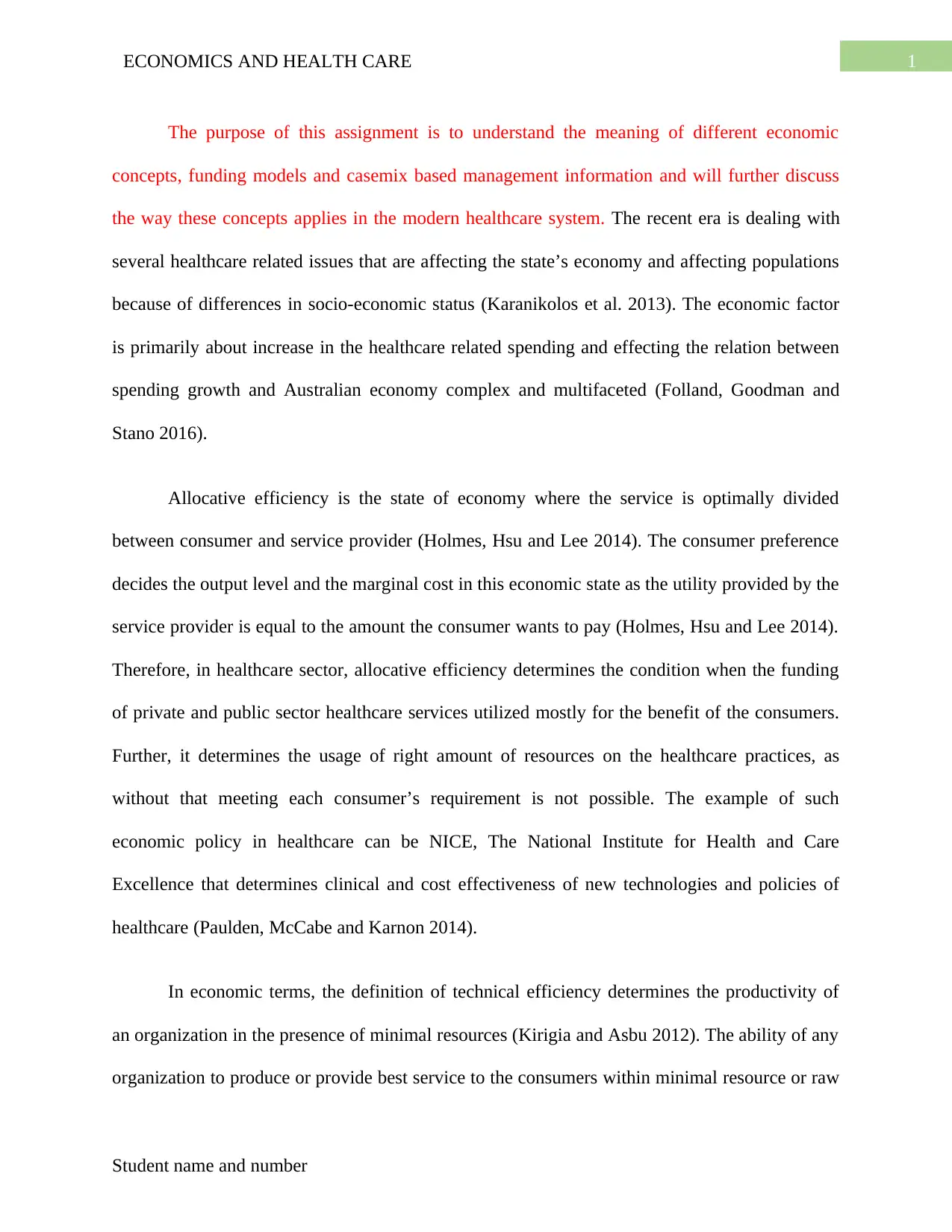
1ECONOMICS AND HEALTH CARE
The purpose of this assignment is to understand the meaning of different economic
concepts, funding models and casemix based management information and will further discuss
the way these concepts applies in the modern healthcare system. The recent era is dealing with
several healthcare related issues that are affecting the state’s economy and affecting populations
because of differences in socio-economic status (Karanikolos et al. 2013). The economic factor
is primarily about increase in the healthcare related spending and effecting the relation between
spending growth and Australian economy complex and multifaceted (Folland, Goodman and
Stano 2016).
Allocative efficiency is the state of economy where the service is optimally divided
between consumer and service provider (Holmes, Hsu and Lee 2014). The consumer preference
decides the output level and the marginal cost in this economic state as the utility provided by the
service provider is equal to the amount the consumer wants to pay (Holmes, Hsu and Lee 2014).
Therefore, in healthcare sector, allocative efficiency determines the condition when the funding
of private and public sector healthcare services utilized mostly for the benefit of the consumers.
Further, it determines the usage of right amount of resources on the healthcare practices, as
without that meeting each consumer’s requirement is not possible. The example of such
economic policy in healthcare can be NICE, The National Institute for Health and Care
Excellence that determines clinical and cost effectiveness of new technologies and policies of
healthcare (Paulden, McCabe and Karnon 2014).
In economic terms, the definition of technical efficiency determines the productivity of
an organization in the presence of minimal resources (Kirigia and Asbu 2012). The ability of any
organization to produce or provide best service to the consumers within minimal resource or raw
Student name and number
The purpose of this assignment is to understand the meaning of different economic
concepts, funding models and casemix based management information and will further discuss
the way these concepts applies in the modern healthcare system. The recent era is dealing with
several healthcare related issues that are affecting the state’s economy and affecting populations
because of differences in socio-economic status (Karanikolos et al. 2013). The economic factor
is primarily about increase in the healthcare related spending and effecting the relation between
spending growth and Australian economy complex and multifaceted (Folland, Goodman and
Stano 2016).
Allocative efficiency is the state of economy where the service is optimally divided
between consumer and service provider (Holmes, Hsu and Lee 2014). The consumer preference
decides the output level and the marginal cost in this economic state as the utility provided by the
service provider is equal to the amount the consumer wants to pay (Holmes, Hsu and Lee 2014).
Therefore, in healthcare sector, allocative efficiency determines the condition when the funding
of private and public sector healthcare services utilized mostly for the benefit of the consumers.
Further, it determines the usage of right amount of resources on the healthcare practices, as
without that meeting each consumer’s requirement is not possible. The example of such
economic policy in healthcare can be NICE, The National Institute for Health and Care
Excellence that determines clinical and cost effectiveness of new technologies and policies of
healthcare (Paulden, McCabe and Karnon 2014).
In economic terms, the definition of technical efficiency determines the productivity of
an organization in the presence of minimal resources (Kirigia and Asbu 2012). The ability of any
organization to produce or provide best service to the consumers within minimal resource or raw
Student name and number
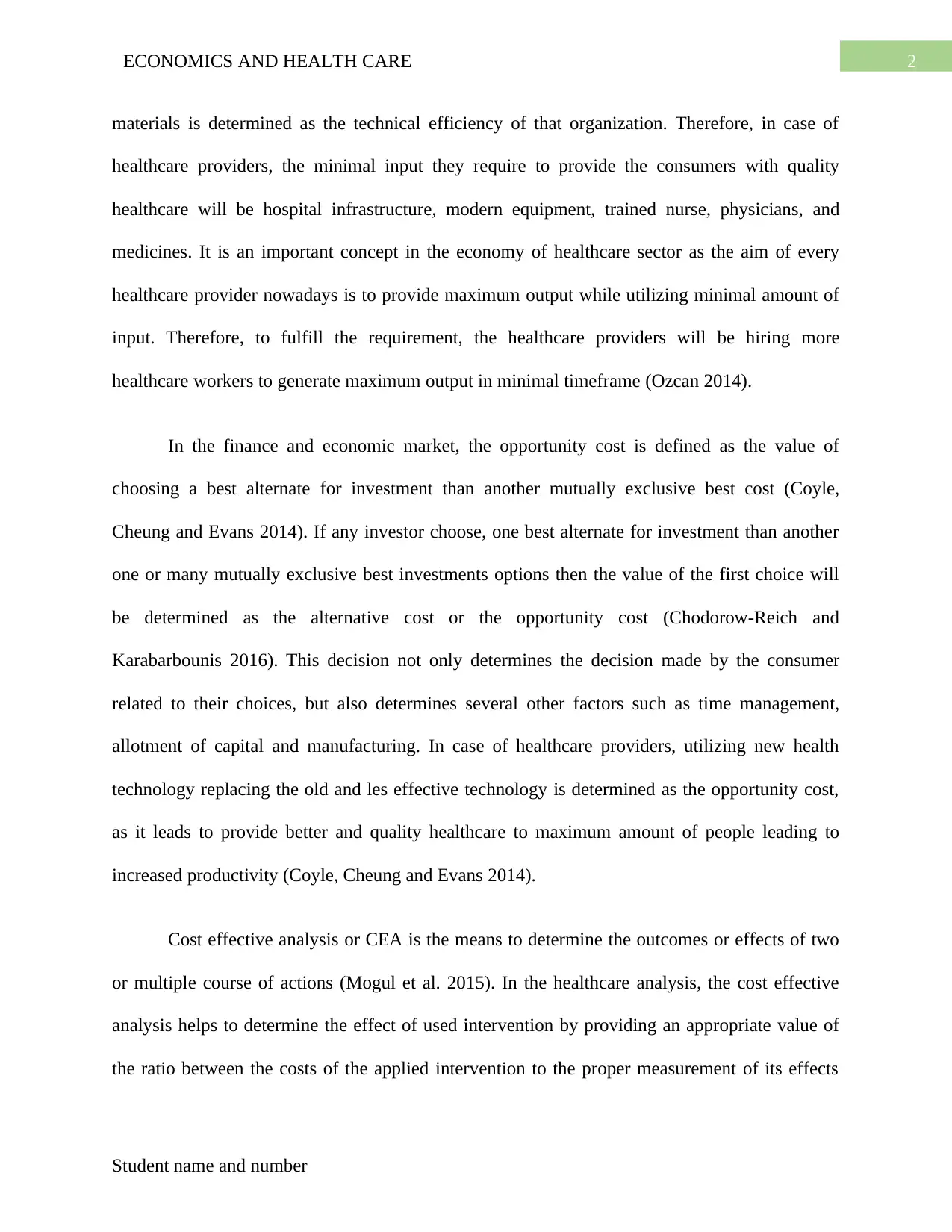
2ECONOMICS AND HEALTH CARE
materials is determined as the technical efficiency of that organization. Therefore, in case of
healthcare providers, the minimal input they require to provide the consumers with quality
healthcare will be hospital infrastructure, modern equipment, trained nurse, physicians, and
medicines. It is an important concept in the economy of healthcare sector as the aim of every
healthcare provider nowadays is to provide maximum output while utilizing minimal amount of
input. Therefore, to fulfill the requirement, the healthcare providers will be hiring more
healthcare workers to generate maximum output in minimal timeframe (Ozcan 2014).
In the finance and economic market, the opportunity cost is defined as the value of
choosing a best alternate for investment than another mutually exclusive best cost (Coyle,
Cheung and Evans 2014). If any investor choose, one best alternate for investment than another
one or many mutually exclusive best investments options then the value of the first choice will
be determined as the alternative cost or the opportunity cost (Chodorow-Reich and
Karabarbounis 2016). This decision not only determines the decision made by the consumer
related to their choices, but also determines several other factors such as time management,
allotment of capital and manufacturing. In case of healthcare providers, utilizing new health
technology replacing the old and les effective technology is determined as the opportunity cost,
as it leads to provide better and quality healthcare to maximum amount of people leading to
increased productivity (Coyle, Cheung and Evans 2014).
Cost effective analysis or CEA is the means to determine the outcomes or effects of two
or multiple course of actions (Mogul et al. 2015). In the healthcare analysis, the cost effective
analysis helps to determine the effect of used intervention by providing an appropriate value of
the ratio between the costs of the applied intervention to the proper measurement of its effects
Student name and number
materials is determined as the technical efficiency of that organization. Therefore, in case of
healthcare providers, the minimal input they require to provide the consumers with quality
healthcare will be hospital infrastructure, modern equipment, trained nurse, physicians, and
medicines. It is an important concept in the economy of healthcare sector as the aim of every
healthcare provider nowadays is to provide maximum output while utilizing minimal amount of
input. Therefore, to fulfill the requirement, the healthcare providers will be hiring more
healthcare workers to generate maximum output in minimal timeframe (Ozcan 2014).
In the finance and economic market, the opportunity cost is defined as the value of
choosing a best alternate for investment than another mutually exclusive best cost (Coyle,
Cheung and Evans 2014). If any investor choose, one best alternate for investment than another
one or many mutually exclusive best investments options then the value of the first choice will
be determined as the alternative cost or the opportunity cost (Chodorow-Reich and
Karabarbounis 2016). This decision not only determines the decision made by the consumer
related to their choices, but also determines several other factors such as time management,
allotment of capital and manufacturing. In case of healthcare providers, utilizing new health
technology replacing the old and les effective technology is determined as the opportunity cost,
as it leads to provide better and quality healthcare to maximum amount of people leading to
increased productivity (Coyle, Cheung and Evans 2014).
Cost effective analysis or CEA is the means to determine the outcomes or effects of two
or multiple course of actions (Mogul et al. 2015). In the healthcare analysis, the cost effective
analysis helps to determine the effect of used intervention by providing an appropriate value of
the ratio between the costs of the applied intervention to the proper measurement of its effects
Student name and number
⊘ This is a preview!⊘
Do you want full access?
Subscribe today to unlock all pages.

Trusted by 1+ million students worldwide
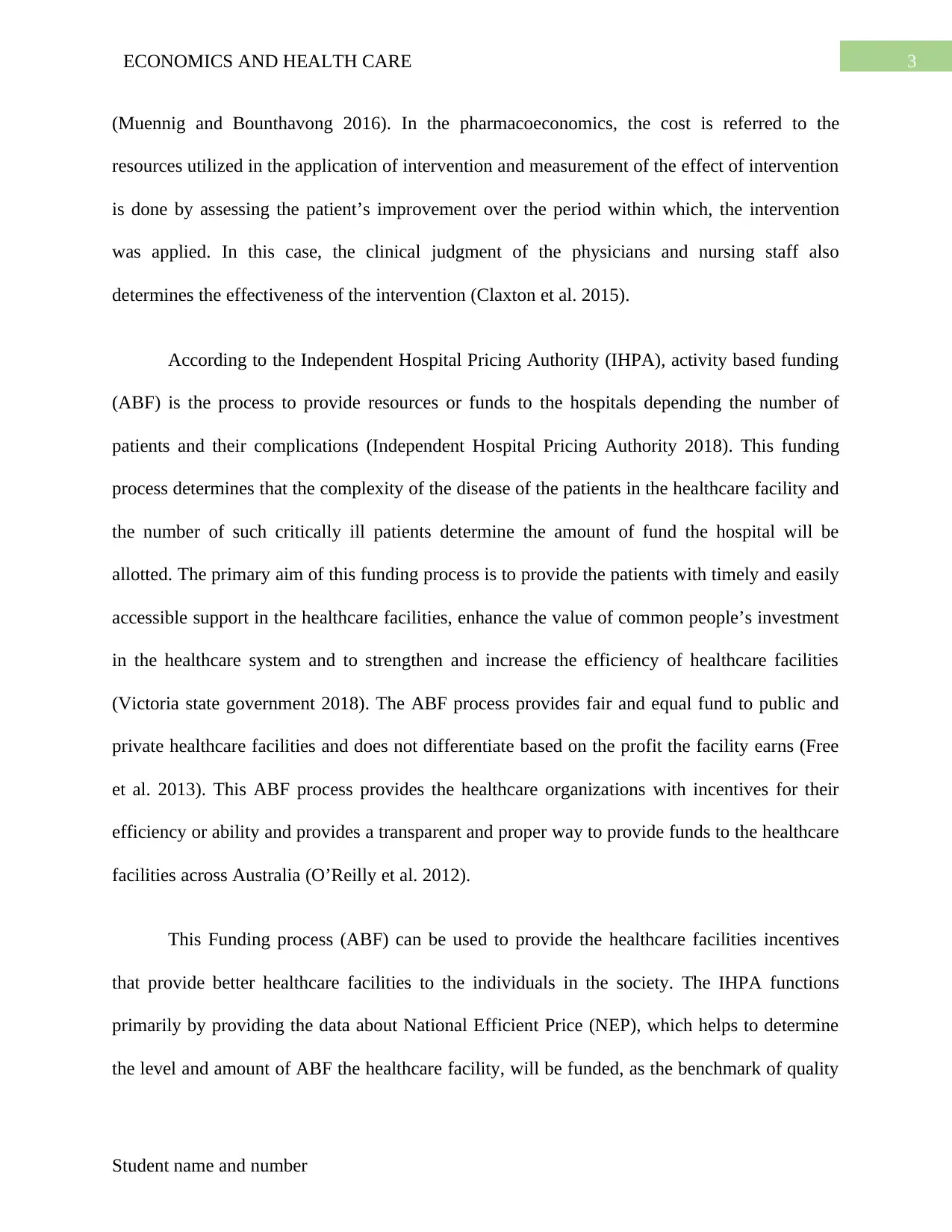
3ECONOMICS AND HEALTH CARE
(Muennig and Bounthavong 2016). In the pharmacoeconomics, the cost is referred to the
resources utilized in the application of intervention and measurement of the effect of intervention
is done by assessing the patient’s improvement over the period within which, the intervention
was applied. In this case, the clinical judgment of the physicians and nursing staff also
determines the effectiveness of the intervention (Claxton et al. 2015).
According to the Independent Hospital Pricing Authority (IHPA), activity based funding
(ABF) is the process to provide resources or funds to the hospitals depending the number of
patients and their complications (Independent Hospital Pricing Authority 2018). This funding
process determines that the complexity of the disease of the patients in the healthcare facility and
the number of such critically ill patients determine the amount of fund the hospital will be
allotted. The primary aim of this funding process is to provide the patients with timely and easily
accessible support in the healthcare facilities, enhance the value of common people’s investment
in the healthcare system and to strengthen and increase the efficiency of healthcare facilities
(Victoria state government 2018). The ABF process provides fair and equal fund to public and
private healthcare facilities and does not differentiate based on the profit the facility earns (Free
et al. 2013). This ABF process provides the healthcare organizations with incentives for their
efficiency or ability and provides a transparent and proper way to provide funds to the healthcare
facilities across Australia (O’Reilly et al. 2012).
This Funding process (ABF) can be used to provide the healthcare facilities incentives
that provide better healthcare facilities to the individuals in the society. The IHPA functions
primarily by providing the data about National Efficient Price (NEP), which helps to determine
the level and amount of ABF the healthcare facility, will be funded, as the benchmark of quality
Student name and number
(Muennig and Bounthavong 2016). In the pharmacoeconomics, the cost is referred to the
resources utilized in the application of intervention and measurement of the effect of intervention
is done by assessing the patient’s improvement over the period within which, the intervention
was applied. In this case, the clinical judgment of the physicians and nursing staff also
determines the effectiveness of the intervention (Claxton et al. 2015).
According to the Independent Hospital Pricing Authority (IHPA), activity based funding
(ABF) is the process to provide resources or funds to the hospitals depending the number of
patients and their complications (Independent Hospital Pricing Authority 2018). This funding
process determines that the complexity of the disease of the patients in the healthcare facility and
the number of such critically ill patients determine the amount of fund the hospital will be
allotted. The primary aim of this funding process is to provide the patients with timely and easily
accessible support in the healthcare facilities, enhance the value of common people’s investment
in the healthcare system and to strengthen and increase the efficiency of healthcare facilities
(Victoria state government 2018). The ABF process provides fair and equal fund to public and
private healthcare facilities and does not differentiate based on the profit the facility earns (Free
et al. 2013). This ABF process provides the healthcare organizations with incentives for their
efficiency or ability and provides a transparent and proper way to provide funds to the healthcare
facilities across Australia (O’Reilly et al. 2012).
This Funding process (ABF) can be used to provide the healthcare facilities incentives
that provide better healthcare facilities to the individuals in the society. The IHPA functions
primarily by providing the data about National Efficient Price (NEP), which helps to determine
the level and amount of ABF the healthcare facility, will be funded, as the benchmark of quality
Student name and number
Paraphrase This Document
Need a fresh take? Get an instant paraphrase of this document with our AI Paraphraser
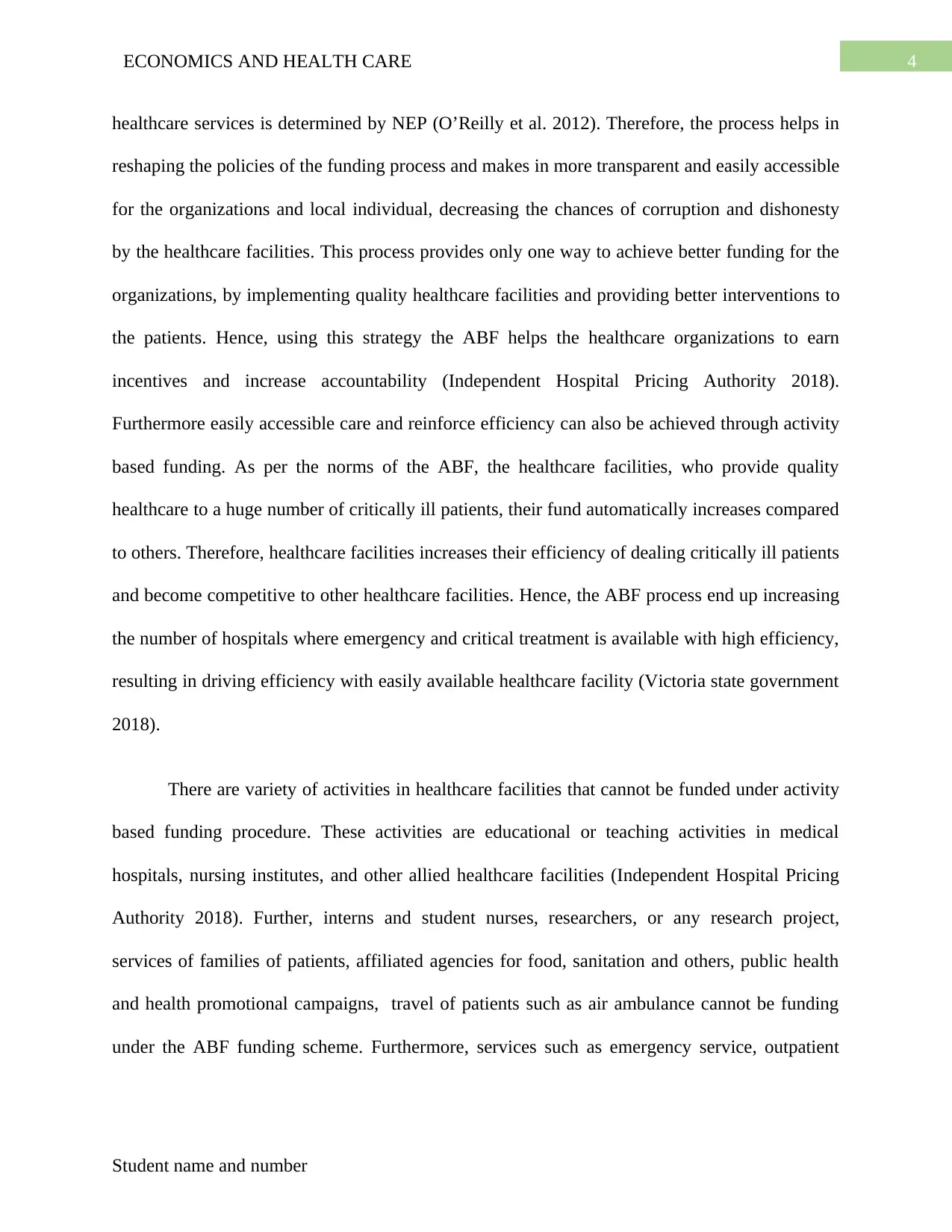
4ECONOMICS AND HEALTH CARE
healthcare services is determined by NEP (O’Reilly et al. 2012). Therefore, the process helps in
reshaping the policies of the funding process and makes in more transparent and easily accessible
for the organizations and local individual, decreasing the chances of corruption and dishonesty
by the healthcare facilities. This process provides only one way to achieve better funding for the
organizations, by implementing quality healthcare facilities and providing better interventions to
the patients. Hence, using this strategy the ABF helps the healthcare organizations to earn
incentives and increase accountability (Independent Hospital Pricing Authority 2018).
Furthermore easily accessible care and reinforce efficiency can also be achieved through activity
based funding. As per the norms of the ABF, the healthcare facilities, who provide quality
healthcare to a huge number of critically ill patients, their fund automatically increases compared
to others. Therefore, healthcare facilities increases their efficiency of dealing critically ill patients
and become competitive to other healthcare facilities. Hence, the ABF process end up increasing
the number of hospitals where emergency and critical treatment is available with high efficiency,
resulting in driving efficiency with easily available healthcare facility (Victoria state government
2018).
There are variety of activities in healthcare facilities that cannot be funded under activity
based funding procedure. These activities are educational or teaching activities in medical
hospitals, nursing institutes, and other allied healthcare facilities (Independent Hospital Pricing
Authority 2018). Further, interns and student nurses, researchers, or any research project,
services of families of patients, affiliated agencies for food, sanitation and others, public health
and health promotional campaigns, travel of patients such as air ambulance cannot be funding
under the ABF funding scheme. Furthermore, services such as emergency service, outpatient
Student name and number
healthcare services is determined by NEP (O’Reilly et al. 2012). Therefore, the process helps in
reshaping the policies of the funding process and makes in more transparent and easily accessible
for the organizations and local individual, decreasing the chances of corruption and dishonesty
by the healthcare facilities. This process provides only one way to achieve better funding for the
organizations, by implementing quality healthcare facilities and providing better interventions to
the patients. Hence, using this strategy the ABF helps the healthcare organizations to earn
incentives and increase accountability (Independent Hospital Pricing Authority 2018).
Furthermore easily accessible care and reinforce efficiency can also be achieved through activity
based funding. As per the norms of the ABF, the healthcare facilities, who provide quality
healthcare to a huge number of critically ill patients, their fund automatically increases compared
to others. Therefore, healthcare facilities increases their efficiency of dealing critically ill patients
and become competitive to other healthcare facilities. Hence, the ABF process end up increasing
the number of hospitals where emergency and critical treatment is available with high efficiency,
resulting in driving efficiency with easily available healthcare facility (Victoria state government
2018).
There are variety of activities in healthcare facilities that cannot be funded under activity
based funding procedure. These activities are educational or teaching activities in medical
hospitals, nursing institutes, and other allied healthcare facilities (Independent Hospital Pricing
Authority 2018). Further, interns and student nurses, researchers, or any research project,
services of families of patients, affiliated agencies for food, sanitation and others, public health
and health promotional campaigns, travel of patients such as air ambulance cannot be funding
under the ABF funding scheme. Furthermore, services such as emergency service, outpatient
Student name and number
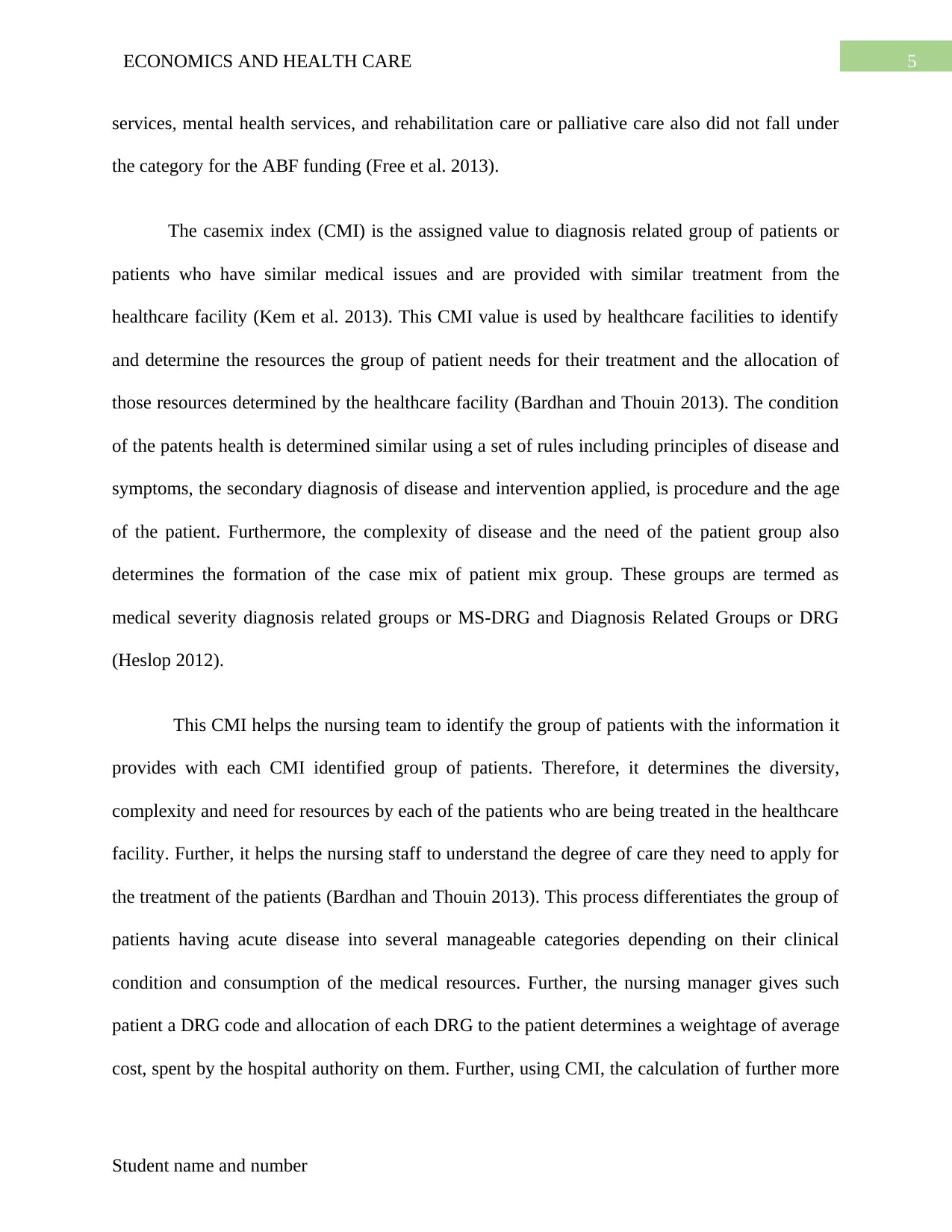
5ECONOMICS AND HEALTH CARE
services, mental health services, and rehabilitation care or palliative care also did not fall under
the category for the ABF funding (Free et al. 2013).
The casemix index (CMI) is the assigned value to diagnosis related group of patients or
patients who have similar medical issues and are provided with similar treatment from the
healthcare facility (Kem et al. 2013). This CMI value is used by healthcare facilities to identify
and determine the resources the group of patient needs for their treatment and the allocation of
those resources determined by the healthcare facility (Bardhan and Thouin 2013). The condition
of the patents health is determined similar using a set of rules including principles of disease and
symptoms, the secondary diagnosis of disease and intervention applied, is procedure and the age
of the patient. Furthermore, the complexity of disease and the need of the patient group also
determines the formation of the case mix of patient mix group. These groups are termed as
medical severity diagnosis related groups or MS-DRG and Diagnosis Related Groups or DRG
(Heslop 2012).
This CMI helps the nursing team to identify the group of patients with the information it
provides with each CMI identified group of patients. Therefore, it determines the diversity,
complexity and need for resources by each of the patients who are being treated in the healthcare
facility. Further, it helps the nursing staff to understand the degree of care they need to apply for
the treatment of the patients (Bardhan and Thouin 2013). This process differentiates the group of
patients having acute disease into several manageable categories depending on their clinical
condition and consumption of the medical resources. Further, the nursing manager gives such
patient a DRG code and allocation of each DRG to the patient determines a weightage of average
cost, spent by the hospital authority on them. Further, using CMI, the calculation of further more
Student name and number
services, mental health services, and rehabilitation care or palliative care also did not fall under
the category for the ABF funding (Free et al. 2013).
The casemix index (CMI) is the assigned value to diagnosis related group of patients or
patients who have similar medical issues and are provided with similar treatment from the
healthcare facility (Kem et al. 2013). This CMI value is used by healthcare facilities to identify
and determine the resources the group of patient needs for their treatment and the allocation of
those resources determined by the healthcare facility (Bardhan and Thouin 2013). The condition
of the patents health is determined similar using a set of rules including principles of disease and
symptoms, the secondary diagnosis of disease and intervention applied, is procedure and the age
of the patient. Furthermore, the complexity of disease and the need of the patient group also
determines the formation of the case mix of patient mix group. These groups are termed as
medical severity diagnosis related groups or MS-DRG and Diagnosis Related Groups or DRG
(Heslop 2012).
This CMI helps the nursing team to identify the group of patients with the information it
provides with each CMI identified group of patients. Therefore, it determines the diversity,
complexity and need for resources by each of the patients who are being treated in the healthcare
facility. Further, it helps the nursing staff to understand the degree of care they need to apply for
the treatment of the patients (Bardhan and Thouin 2013). This process differentiates the group of
patients having acute disease into several manageable categories depending on their clinical
condition and consumption of the medical resources. Further, the nursing manager gives such
patient a DRG code and allocation of each DRG to the patient determines a weightage of average
cost, spent by the hospital authority on them. Further, using CMI, the calculation of further more
Student name and number
⊘ This is a preview!⊘
Do you want full access?
Subscribe today to unlock all pages.

Trusted by 1+ million students worldwide
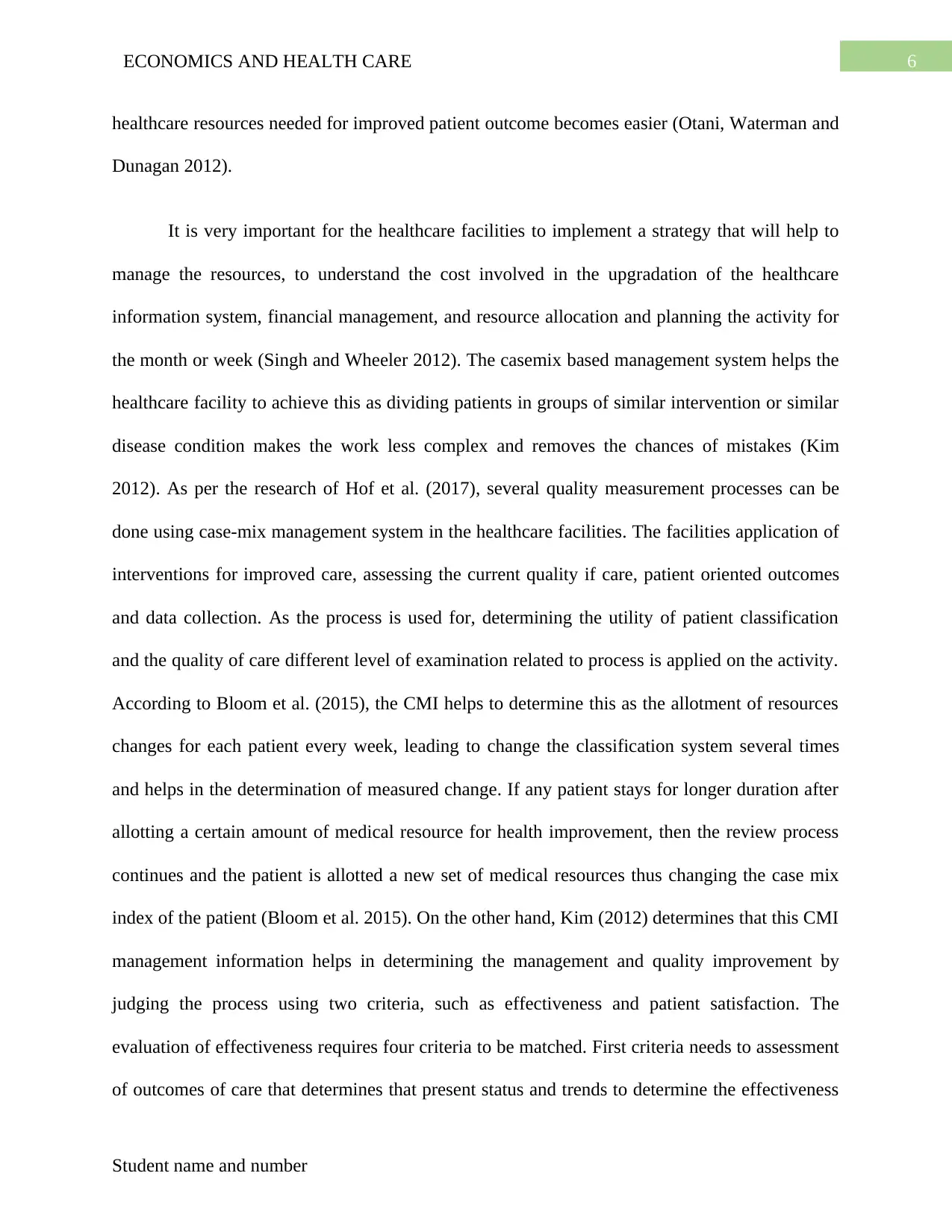
6ECONOMICS AND HEALTH CARE
healthcare resources needed for improved patient outcome becomes easier (Otani, Waterman and
Dunagan 2012).
It is very important for the healthcare facilities to implement a strategy that will help to
manage the resources, to understand the cost involved in the upgradation of the healthcare
information system, financial management, and resource allocation and planning the activity for
the month or week (Singh and Wheeler 2012). The casemix based management system helps the
healthcare facility to achieve this as dividing patients in groups of similar intervention or similar
disease condition makes the work less complex and removes the chances of mistakes (Kim
2012). As per the research of Hof et al. (2017), several quality measurement processes can be
done using case-mix management system in the healthcare facilities. The facilities application of
interventions for improved care, assessing the current quality if care, patient oriented outcomes
and data collection. As the process is used for, determining the utility of patient classification
and the quality of care different level of examination related to process is applied on the activity.
According to Bloom et al. (2015), the CMI helps to determine this as the allotment of resources
changes for each patient every week, leading to change the classification system several times
and helps in the determination of measured change. If any patient stays for longer duration after
allotting a certain amount of medical resource for health improvement, then the review process
continues and the patient is allotted a new set of medical resources thus changing the case mix
index of the patient (Bloom et al. 2015). On the other hand, Kim (2012) determines that this CMI
management information helps in determining the management and quality improvement by
judging the process using two criteria, such as effectiveness and patient satisfaction. The
evaluation of effectiveness requires four criteria to be matched. First criteria needs to assessment
of outcomes of care that determines that present status and trends to determine the effectiveness
Student name and number
healthcare resources needed for improved patient outcome becomes easier (Otani, Waterman and
Dunagan 2012).
It is very important for the healthcare facilities to implement a strategy that will help to
manage the resources, to understand the cost involved in the upgradation of the healthcare
information system, financial management, and resource allocation and planning the activity for
the month or week (Singh and Wheeler 2012). The casemix based management system helps the
healthcare facility to achieve this as dividing patients in groups of similar intervention or similar
disease condition makes the work less complex and removes the chances of mistakes (Kim
2012). As per the research of Hof et al. (2017), several quality measurement processes can be
done using case-mix management system in the healthcare facilities. The facilities application of
interventions for improved care, assessing the current quality if care, patient oriented outcomes
and data collection. As the process is used for, determining the utility of patient classification
and the quality of care different level of examination related to process is applied on the activity.
According to Bloom et al. (2015), the CMI helps to determine this as the allotment of resources
changes for each patient every week, leading to change the classification system several times
and helps in the determination of measured change. If any patient stays for longer duration after
allotting a certain amount of medical resource for health improvement, then the review process
continues and the patient is allotted a new set of medical resources thus changing the case mix
index of the patient (Bloom et al. 2015). On the other hand, Kim (2012) determines that this CMI
management information helps in determining the management and quality improvement by
judging the process using two criteria, such as effectiveness and patient satisfaction. The
evaluation of effectiveness requires four criteria to be matched. First criteria needs to assessment
of outcomes of care that determines that present status and trends to determine the effectiveness
Student name and number
Paraphrase This Document
Need a fresh take? Get an instant paraphrase of this document with our AI Paraphraser
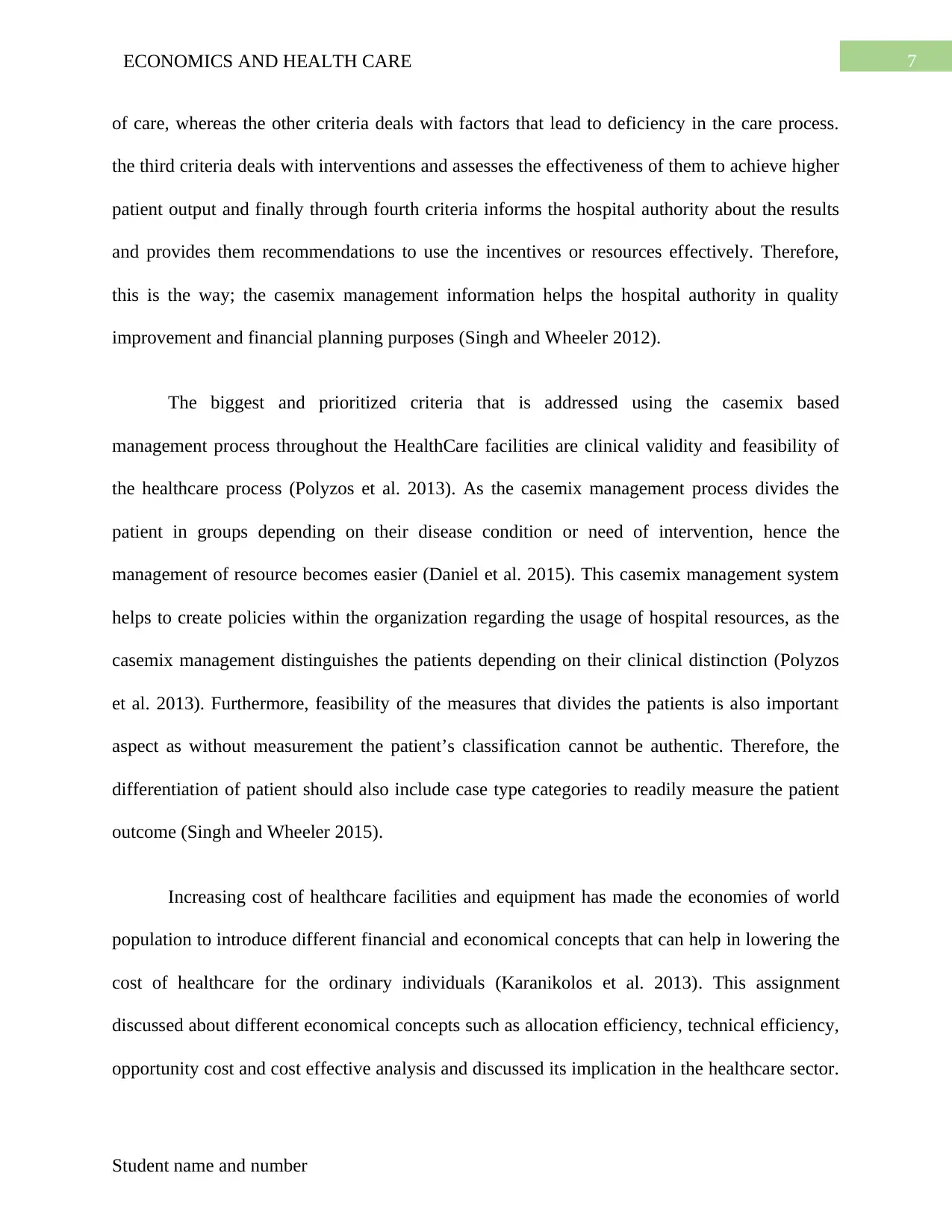
7ECONOMICS AND HEALTH CARE
of care, whereas the other criteria deals with factors that lead to deficiency in the care process.
the third criteria deals with interventions and assesses the effectiveness of them to achieve higher
patient output and finally through fourth criteria informs the hospital authority about the results
and provides them recommendations to use the incentives or resources effectively. Therefore,
this is the way; the casemix management information helps the hospital authority in quality
improvement and financial planning purposes (Singh and Wheeler 2012).
The biggest and prioritized criteria that is addressed using the casemix based
management process throughout the HealthCare facilities are clinical validity and feasibility of
the healthcare process (Polyzos et al. 2013). As the casemix management process divides the
patient in groups depending on their disease condition or need of intervention, hence the
management of resource becomes easier (Daniel et al. 2015). This casemix management system
helps to create policies within the organization regarding the usage of hospital resources, as the
casemix management distinguishes the patients depending on their clinical distinction (Polyzos
et al. 2013). Furthermore, feasibility of the measures that divides the patients is also important
aspect as without measurement the patient’s classification cannot be authentic. Therefore, the
differentiation of patient should also include case type categories to readily measure the patient
outcome (Singh and Wheeler 2015).
Increasing cost of healthcare facilities and equipment has made the economies of world
population to introduce different financial and economical concepts that can help in lowering the
cost of healthcare for the ordinary individuals (Karanikolos et al. 2013). This assignment
discussed about different economical concepts such as allocation efficiency, technical efficiency,
opportunity cost and cost effective analysis and discussed its implication in the healthcare sector.
Student name and number
of care, whereas the other criteria deals with factors that lead to deficiency in the care process.
the third criteria deals with interventions and assesses the effectiveness of them to achieve higher
patient output and finally through fourth criteria informs the hospital authority about the results
and provides them recommendations to use the incentives or resources effectively. Therefore,
this is the way; the casemix management information helps the hospital authority in quality
improvement and financial planning purposes (Singh and Wheeler 2012).
The biggest and prioritized criteria that is addressed using the casemix based
management process throughout the HealthCare facilities are clinical validity and feasibility of
the healthcare process (Polyzos et al. 2013). As the casemix management process divides the
patient in groups depending on their disease condition or need of intervention, hence the
management of resource becomes easier (Daniel et al. 2015). This casemix management system
helps to create policies within the organization regarding the usage of hospital resources, as the
casemix management distinguishes the patients depending on their clinical distinction (Polyzos
et al. 2013). Furthermore, feasibility of the measures that divides the patients is also important
aspect as without measurement the patient’s classification cannot be authentic. Therefore, the
differentiation of patient should also include case type categories to readily measure the patient
outcome (Singh and Wheeler 2015).
Increasing cost of healthcare facilities and equipment has made the economies of world
population to introduce different financial and economical concepts that can help in lowering the
cost of healthcare for the ordinary individuals (Karanikolos et al. 2013). This assignment
discussed about different economical concepts such as allocation efficiency, technical efficiency,
opportunity cost and cost effective analysis and discussed its implication in the healthcare sector.
Student name and number
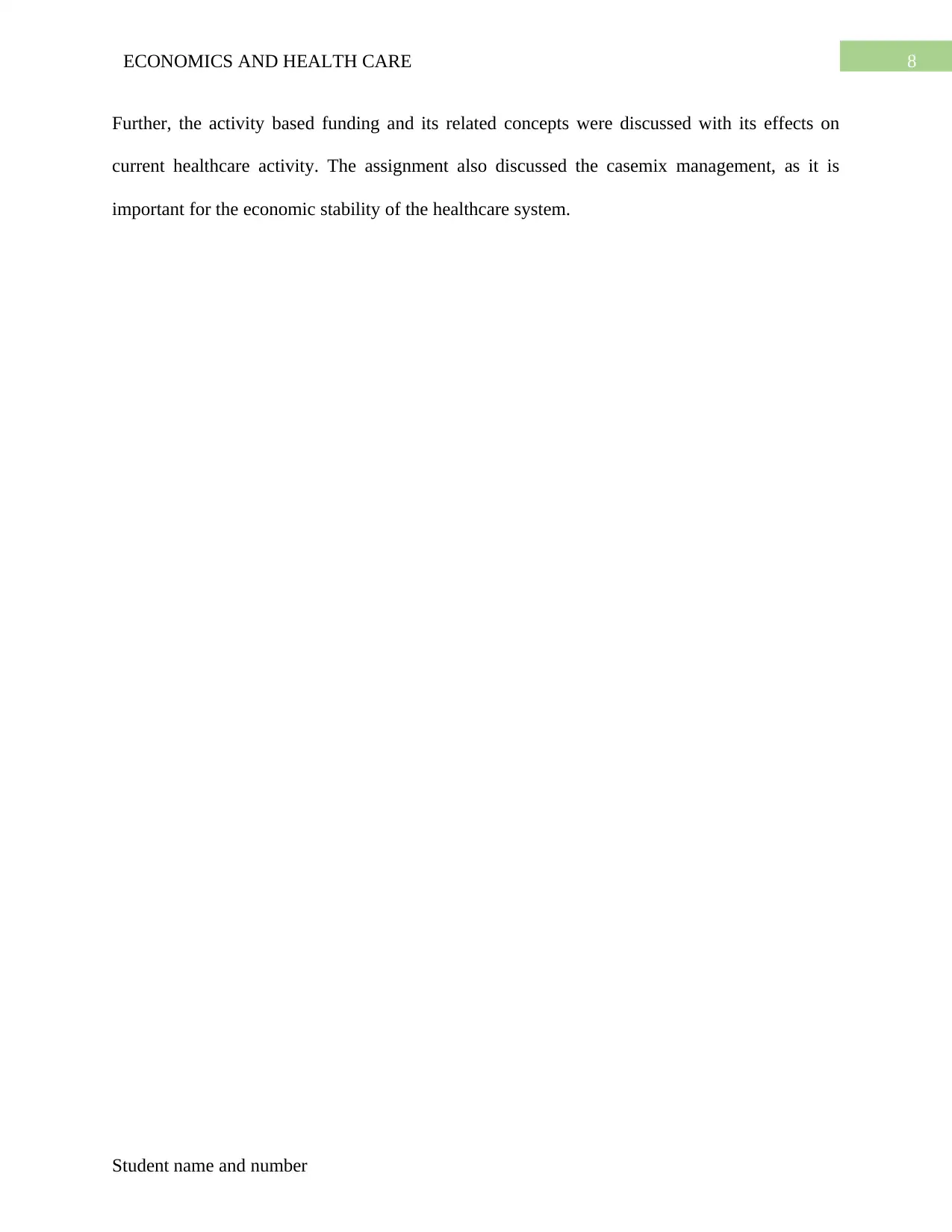
8ECONOMICS AND HEALTH CARE
Further, the activity based funding and its related concepts were discussed with its effects on
current healthcare activity. The assignment also discussed the casemix management, as it is
important for the economic stability of the healthcare system.
Student name and number
Further, the activity based funding and its related concepts were discussed with its effects on
current healthcare activity. The assignment also discussed the casemix management, as it is
important for the economic stability of the healthcare system.
Student name and number
⊘ This is a preview!⊘
Do you want full access?
Subscribe today to unlock all pages.

Trusted by 1+ million students worldwide
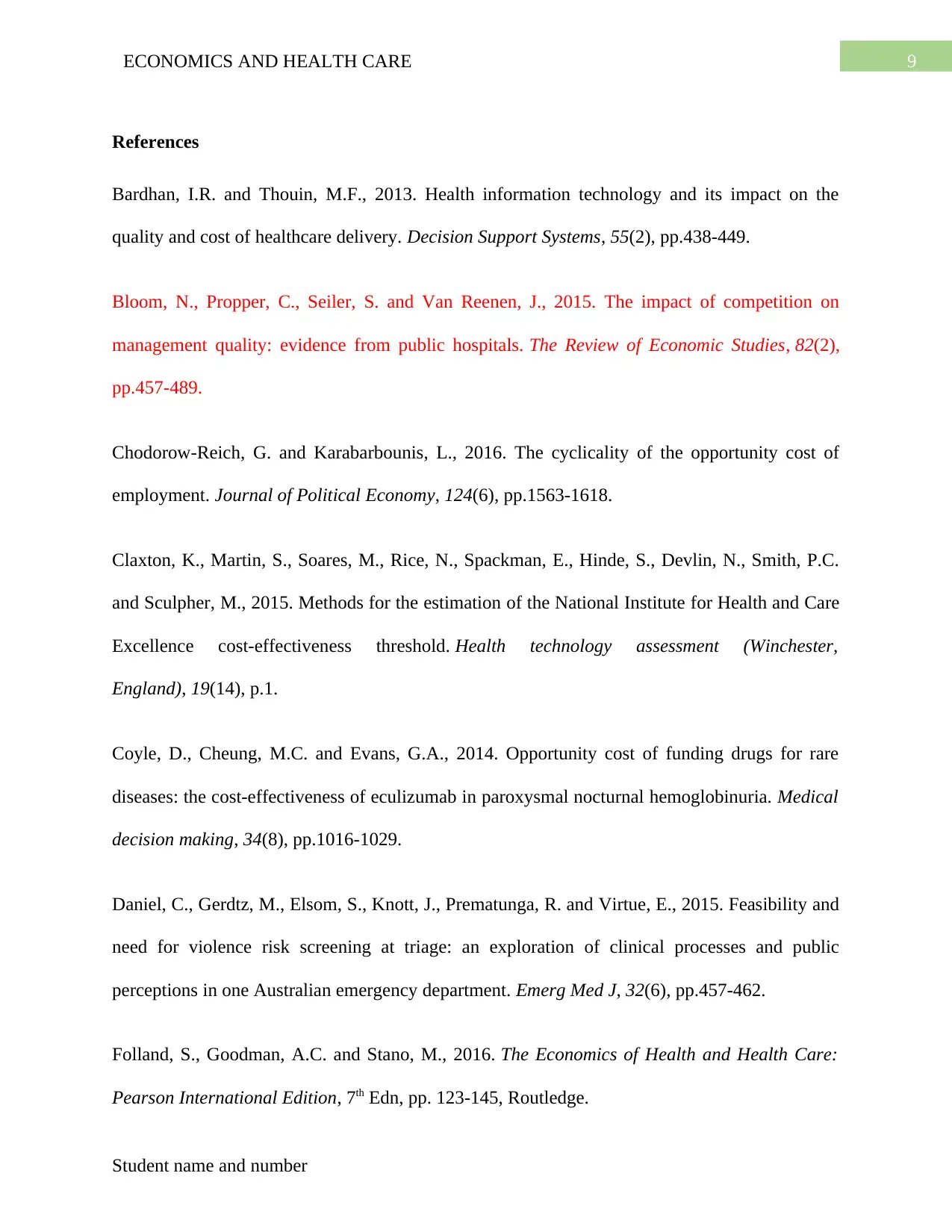
9ECONOMICS AND HEALTH CARE
References
Bardhan, I.R. and Thouin, M.F., 2013. Health information technology and its impact on the
quality and cost of healthcare delivery. Decision Support Systems, 55(2), pp.438-449.
Bloom, N., Propper, C., Seiler, S. and Van Reenen, J., 2015. The impact of competition on
management quality: evidence from public hospitals. The Review of Economic Studies, 82(2),
pp.457-489.
Chodorow-Reich, G. and Karabarbounis, L., 2016. The cyclicality of the opportunity cost of
employment. Journal of Political Economy, 124(6), pp.1563-1618.
Claxton, K., Martin, S., Soares, M., Rice, N., Spackman, E., Hinde, S., Devlin, N., Smith, P.C.
and Sculpher, M., 2015. Methods for the estimation of the National Institute for Health and Care
Excellence cost-effectiveness threshold. Health technology assessment (Winchester,
England), 19(14), p.1.
Coyle, D., Cheung, M.C. and Evans, G.A., 2014. Opportunity cost of funding drugs for rare
diseases: the cost-effectiveness of eculizumab in paroxysmal nocturnal hemoglobinuria. Medical
decision making, 34(8), pp.1016-1029.
Daniel, C., Gerdtz, M., Elsom, S., Knott, J., Prematunga, R. and Virtue, E., 2015. Feasibility and
need for violence risk screening at triage: an exploration of clinical processes and public
perceptions in one Australian emergency department. Emerg Med J, 32(6), pp.457-462.
Folland, S., Goodman, A.C. and Stano, M., 2016. The Economics of Health and Health Care:
Pearson International Edition, 7th Edn, pp. 123-145, Routledge.
Student name and number
References
Bardhan, I.R. and Thouin, M.F., 2013. Health information technology and its impact on the
quality and cost of healthcare delivery. Decision Support Systems, 55(2), pp.438-449.
Bloom, N., Propper, C., Seiler, S. and Van Reenen, J., 2015. The impact of competition on
management quality: evidence from public hospitals. The Review of Economic Studies, 82(2),
pp.457-489.
Chodorow-Reich, G. and Karabarbounis, L., 2016. The cyclicality of the opportunity cost of
employment. Journal of Political Economy, 124(6), pp.1563-1618.
Claxton, K., Martin, S., Soares, M., Rice, N., Spackman, E., Hinde, S., Devlin, N., Smith, P.C.
and Sculpher, M., 2015. Methods for the estimation of the National Institute for Health and Care
Excellence cost-effectiveness threshold. Health technology assessment (Winchester,
England), 19(14), p.1.
Coyle, D., Cheung, M.C. and Evans, G.A., 2014. Opportunity cost of funding drugs for rare
diseases: the cost-effectiveness of eculizumab in paroxysmal nocturnal hemoglobinuria. Medical
decision making, 34(8), pp.1016-1029.
Daniel, C., Gerdtz, M., Elsom, S., Knott, J., Prematunga, R. and Virtue, E., 2015. Feasibility and
need for violence risk screening at triage: an exploration of clinical processes and public
perceptions in one Australian emergency department. Emerg Med J, 32(6), pp.457-462.
Folland, S., Goodman, A.C. and Stano, M., 2016. The Economics of Health and Health Care:
Pearson International Edition, 7th Edn, pp. 123-145, Routledge.
Student name and number
Paraphrase This Document
Need a fresh take? Get an instant paraphrase of this document with our AI Paraphraser
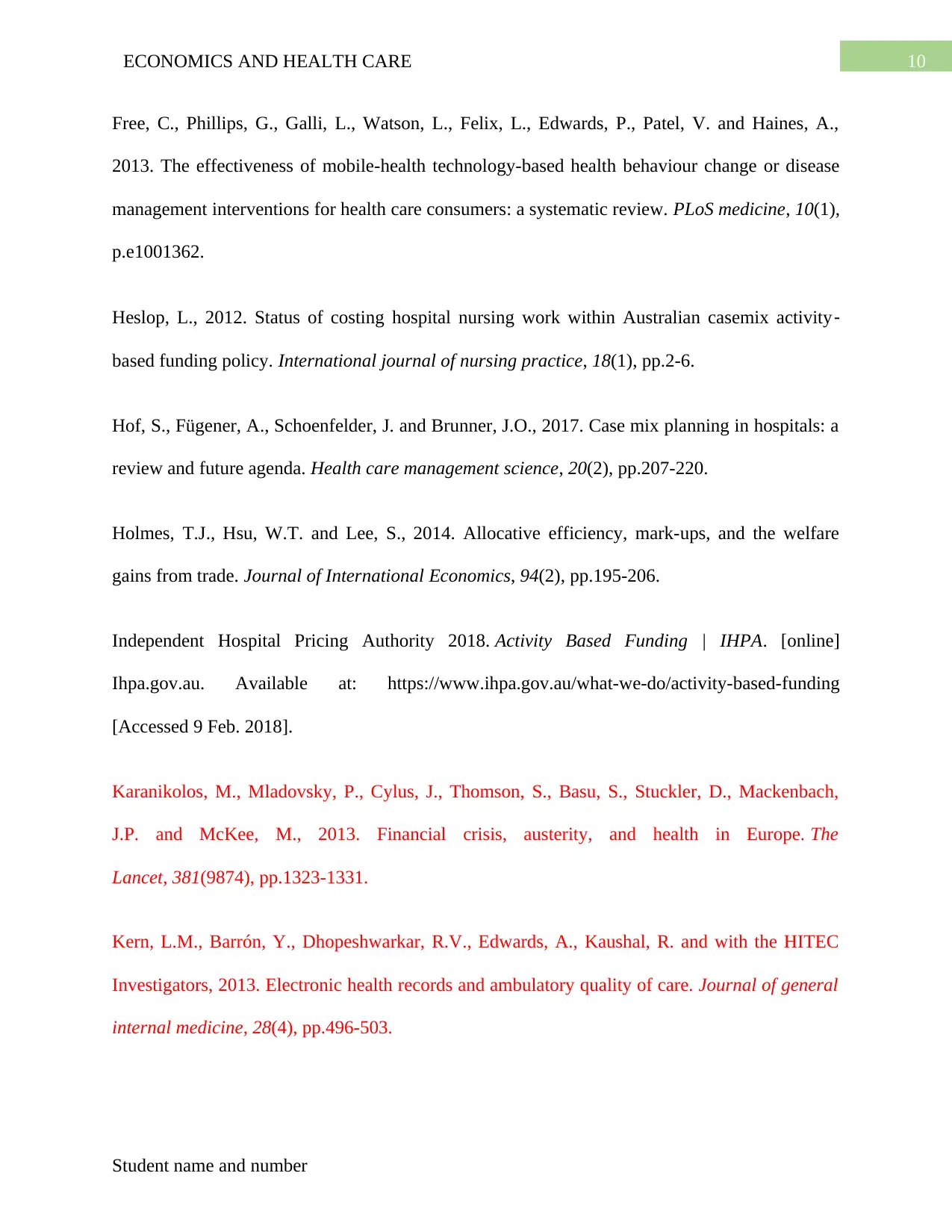
10ECONOMICS AND HEALTH CARE
Free, C., Phillips, G., Galli, L., Watson, L., Felix, L., Edwards, P., Patel, V. and Haines, A.,
2013. The effectiveness of mobile-health technology-based health behaviour change or disease
management interventions for health care consumers: a systematic review. PLoS medicine, 10(1),
p.e1001362.
Heslop, L., 2012. Status of costing hospital nursing work within Australian casemix activity‐
based funding policy. International journal of nursing practice, 18(1), pp.2-6.
Hof, S., Fügener, A., Schoenfelder, J. and Brunner, J.O., 2017. Case mix planning in hospitals: a
review and future agenda. Health care management science, 20(2), pp.207-220.
Holmes, T.J., Hsu, W.T. and Lee, S., 2014. Allocative efficiency, mark-ups, and the welfare
gains from trade. Journal of International Economics, 94(2), pp.195-206.
Independent Hospital Pricing Authority 2018. Activity Based Funding | IHPA. [online]
Ihpa.gov.au. Available at: https://www.ihpa.gov.au/what-we-do/activity-based-funding
[Accessed 9 Feb. 2018].
Karanikolos, M., Mladovsky, P., Cylus, J., Thomson, S., Basu, S., Stuckler, D., Mackenbach,
J.P. and McKee, M., 2013. Financial crisis, austerity, and health in Europe. The
Lancet, 381(9874), pp.1323-1331.
Kern, L.M., Barrón, Y., Dhopeshwarkar, R.V., Edwards, A., Kaushal, R. and with the HITEC
Investigators, 2013. Electronic health records and ambulatory quality of care. Journal of general
internal medicine, 28(4), pp.496-503.
Student name and number
Free, C., Phillips, G., Galli, L., Watson, L., Felix, L., Edwards, P., Patel, V. and Haines, A.,
2013. The effectiveness of mobile-health technology-based health behaviour change or disease
management interventions for health care consumers: a systematic review. PLoS medicine, 10(1),
p.e1001362.
Heslop, L., 2012. Status of costing hospital nursing work within Australian casemix activity‐
based funding policy. International journal of nursing practice, 18(1), pp.2-6.
Hof, S., Fügener, A., Schoenfelder, J. and Brunner, J.O., 2017. Case mix planning in hospitals: a
review and future agenda. Health care management science, 20(2), pp.207-220.
Holmes, T.J., Hsu, W.T. and Lee, S., 2014. Allocative efficiency, mark-ups, and the welfare
gains from trade. Journal of International Economics, 94(2), pp.195-206.
Independent Hospital Pricing Authority 2018. Activity Based Funding | IHPA. [online]
Ihpa.gov.au. Available at: https://www.ihpa.gov.au/what-we-do/activity-based-funding
[Accessed 9 Feb. 2018].
Karanikolos, M., Mladovsky, P., Cylus, J., Thomson, S., Basu, S., Stuckler, D., Mackenbach,
J.P. and McKee, M., 2013. Financial crisis, austerity, and health in Europe. The
Lancet, 381(9874), pp.1323-1331.
Kern, L.M., Barrón, Y., Dhopeshwarkar, R.V., Edwards, A., Kaushal, R. and with the HITEC
Investigators, 2013. Electronic health records and ambulatory quality of care. Journal of general
internal medicine, 28(4), pp.496-503.
Student name and number
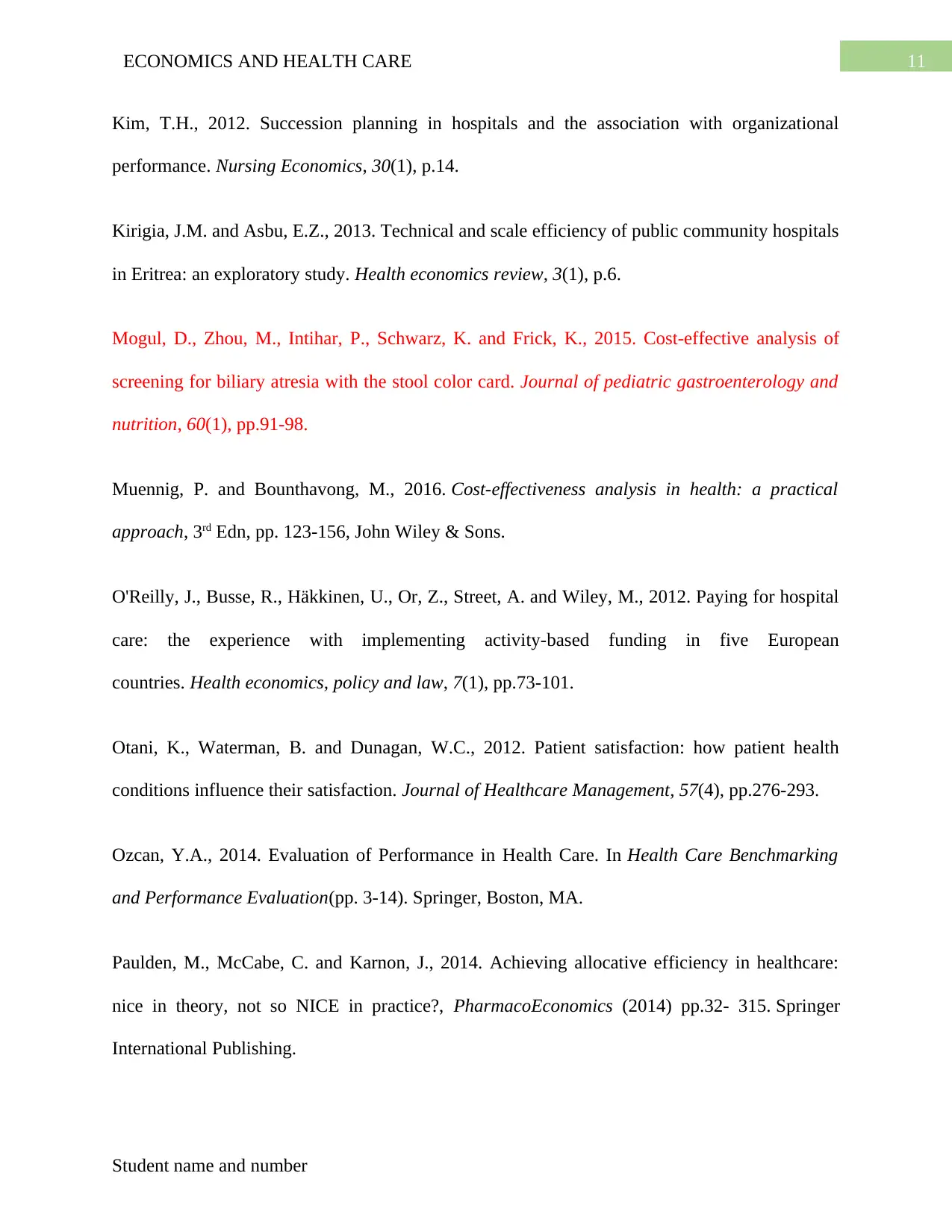
11ECONOMICS AND HEALTH CARE
Kim, T.H., 2012. Succession planning in hospitals and the association with organizational
performance. Nursing Economics, 30(1), p.14.
Kirigia, J.M. and Asbu, E.Z., 2013. Technical and scale efficiency of public community hospitals
in Eritrea: an exploratory study. Health economics review, 3(1), p.6.
Mogul, D., Zhou, M., Intihar, P., Schwarz, K. and Frick, K., 2015. Cost-effective analysis of
screening for biliary atresia with the stool color card. Journal of pediatric gastroenterology and
nutrition, 60(1), pp.91-98.
Muennig, P. and Bounthavong, M., 2016. Cost-effectiveness analysis in health: a practical
approach, 3rd Edn, pp. 123-156, John Wiley & Sons.
O'Reilly, J., Busse, R., Häkkinen, U., Or, Z., Street, A. and Wiley, M., 2012. Paying for hospital
care: the experience with implementing activity-based funding in five European
countries. Health economics, policy and law, 7(1), pp.73-101.
Otani, K., Waterman, B. and Dunagan, W.C., 2012. Patient satisfaction: how patient health
conditions influence their satisfaction. Journal of Healthcare Management, 57(4), pp.276-293.
Ozcan, Y.A., 2014. Evaluation of Performance in Health Care. In Health Care Benchmarking
and Performance Evaluation(pp. 3-14). Springer, Boston, MA.
Paulden, M., McCabe, C. and Karnon, J., 2014. Achieving allocative efficiency in healthcare:
nice in theory, not so NICE in practice?, PharmacoEconomics (2014) pp.32- 315. Springer
International Publishing.
Student name and number
Kim, T.H., 2012. Succession planning in hospitals and the association with organizational
performance. Nursing Economics, 30(1), p.14.
Kirigia, J.M. and Asbu, E.Z., 2013. Technical and scale efficiency of public community hospitals
in Eritrea: an exploratory study. Health economics review, 3(1), p.6.
Mogul, D., Zhou, M., Intihar, P., Schwarz, K. and Frick, K., 2015. Cost-effective analysis of
screening for biliary atresia with the stool color card. Journal of pediatric gastroenterology and
nutrition, 60(1), pp.91-98.
Muennig, P. and Bounthavong, M., 2016. Cost-effectiveness analysis in health: a practical
approach, 3rd Edn, pp. 123-156, John Wiley & Sons.
O'Reilly, J., Busse, R., Häkkinen, U., Or, Z., Street, A. and Wiley, M., 2012. Paying for hospital
care: the experience with implementing activity-based funding in five European
countries. Health economics, policy and law, 7(1), pp.73-101.
Otani, K., Waterman, B. and Dunagan, W.C., 2012. Patient satisfaction: how patient health
conditions influence their satisfaction. Journal of Healthcare Management, 57(4), pp.276-293.
Ozcan, Y.A., 2014. Evaluation of Performance in Health Care. In Health Care Benchmarking
and Performance Evaluation(pp. 3-14). Springer, Boston, MA.
Paulden, M., McCabe, C. and Karnon, J., 2014. Achieving allocative efficiency in healthcare:
nice in theory, not so NICE in practice?, PharmacoEconomics (2014) pp.32- 315. Springer
International Publishing.
Student name and number
⊘ This is a preview!⊘
Do you want full access?
Subscribe today to unlock all pages.

Trusted by 1+ million students worldwide
1 out of 13
Related Documents
Your All-in-One AI-Powered Toolkit for Academic Success.
+13062052269
info@desklib.com
Available 24*7 on WhatsApp / Email
![[object Object]](/_next/static/media/star-bottom.7253800d.svg)
Unlock your academic potential
Copyright © 2020–2025 A2Z Services. All Rights Reserved. Developed and managed by ZUCOL.




